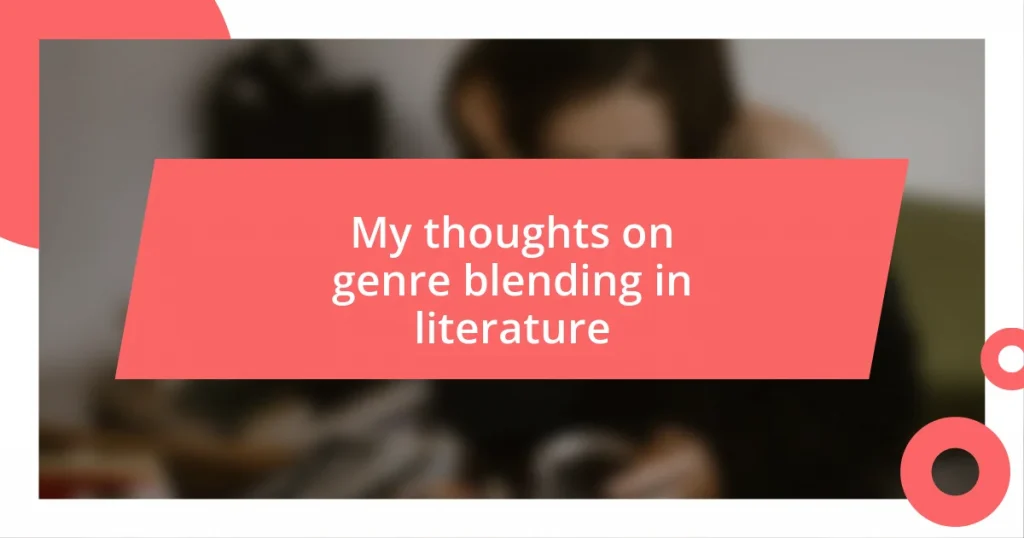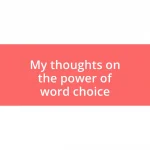Key takeaways:
- Genre blending has a rich historical context, with notable examples throughout literature, such as Shakespeare’s mixes of tragedy and comedy, Gothic novels, and magical realism.
- Effective techniques for genre blending include establishing strong thematic connections, experimenting with narrative structures, and utilizing stylistic contrasts to enhance emotional resonance.
- Challenges in genre blending involve balancing genre integrity, managing reader expectations, and avoiding alienation of genre-specific audiences, while future trends promise innovative combinations fueled by personal narratives and technology.
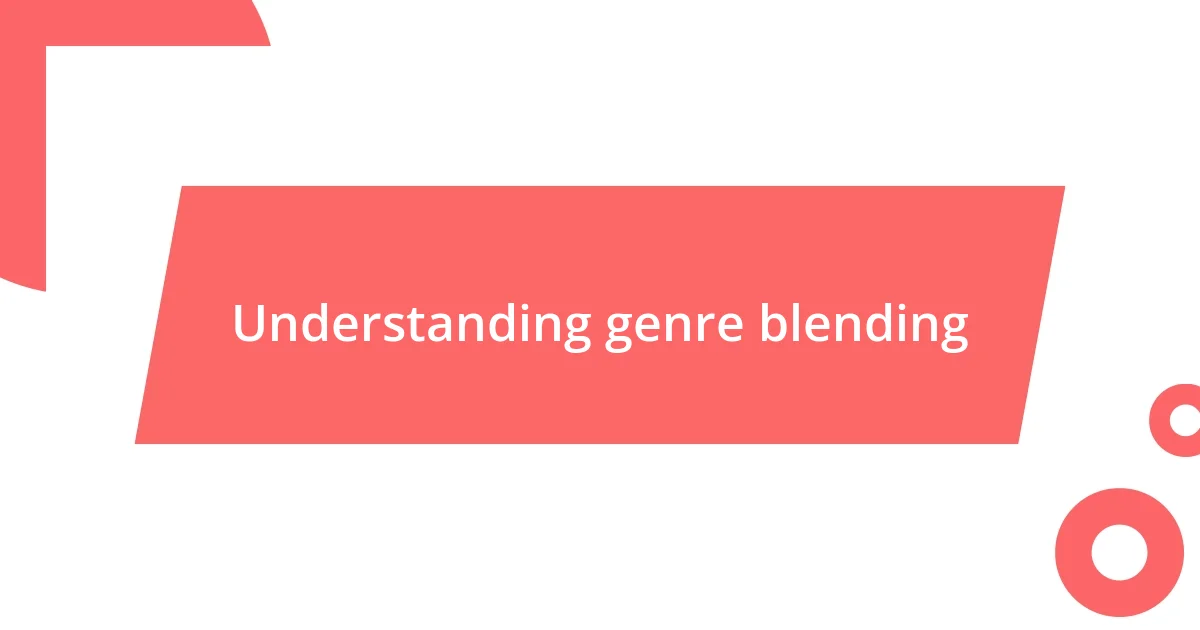
Understanding genre blending
Genre blending in literature is a fascinating concept that invites authors to break traditional boundaries. I vividly remember reading a novel that flitted between romance and science fiction, weaving these worlds together seamlessly. It made me question, what if the rules are more like guidelines?
When I dive into a blended genre, I often find myself captivated by the unexpected textures and layers it creates. For instance, a fantasy novel infused with mystery can lead to thrilling twists that keep me on my toes. Isn’t it exciting when a story surprises you? It’s like being invited to a party where the guests are all from different worlds, each bringing a unique flavor to the mix.
I think genre blending can also spark innovation, inspiring authors to explore themes in new ways. For example, I’ve seen horror blend with romance, illuminating the darker aspects of love and loss. How does blending genres allow us to discover deeper truths about the human experience? It challenges both writers and readers to rethink storytelling and embrace the unpredictable journey that literature can offer.
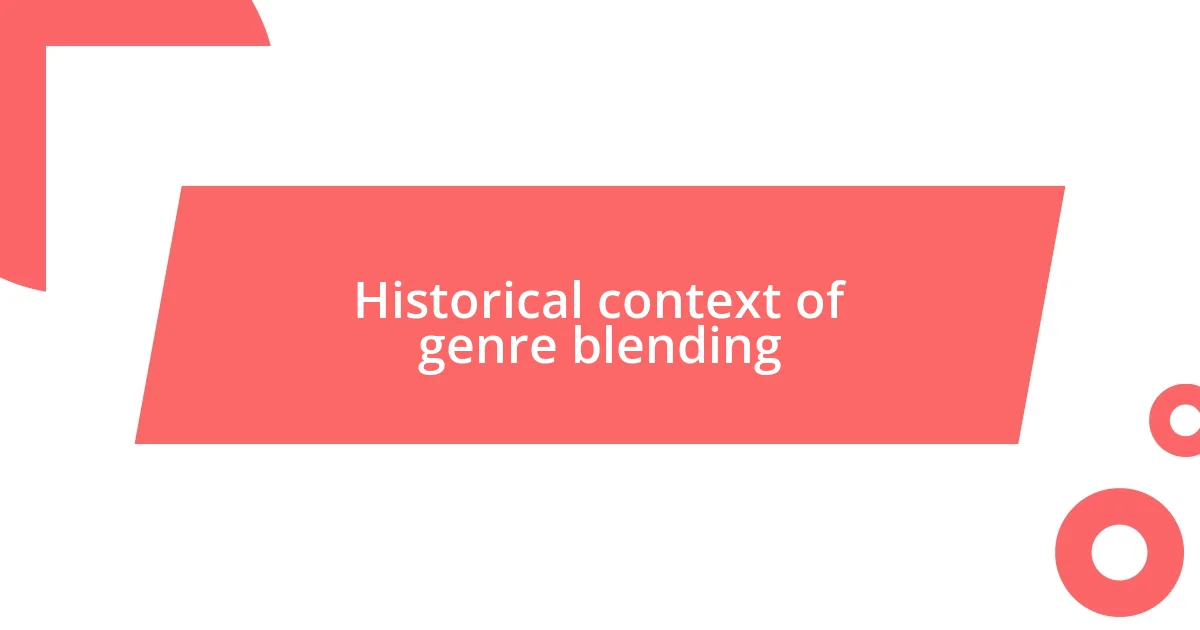
Historical context of genre blending
The historical context of genre blending shows that it’s not a new phenomenon; it’s been around for centuries, often reflecting societal changes and cultural exchanges. For example, during the Renaissance, authors like Shakespeare mixed elements of tragedy and comedy in a way that defied strict genre classifications. I remember the first time I watched “Romeo and Juliet,” finding it striking how the combination of romance and tragedy evoked such powerful emotions—it made me see the flexibility of storytelling.
Throughout literature’s evolution, genre blending has thrived in various forms:
- The Gothic novel introduced romance intertwined with horror, showcasing complex human emotions.
- Magical realism emerged, mixing fantastical elements with everyday life, leading to captivating narratives that challenge perceptions of reality.
- Modern works, such as graphic novels, often merge visual art with storytelling, further blurring the lines between genres.
Reflecting on how these genres evolved reminds me of how my reading preferences shifted as I encountered more mixed narratives. Each genre blend has shaped my understanding of literature and pushed me to appreciate the nuances within storytelling.
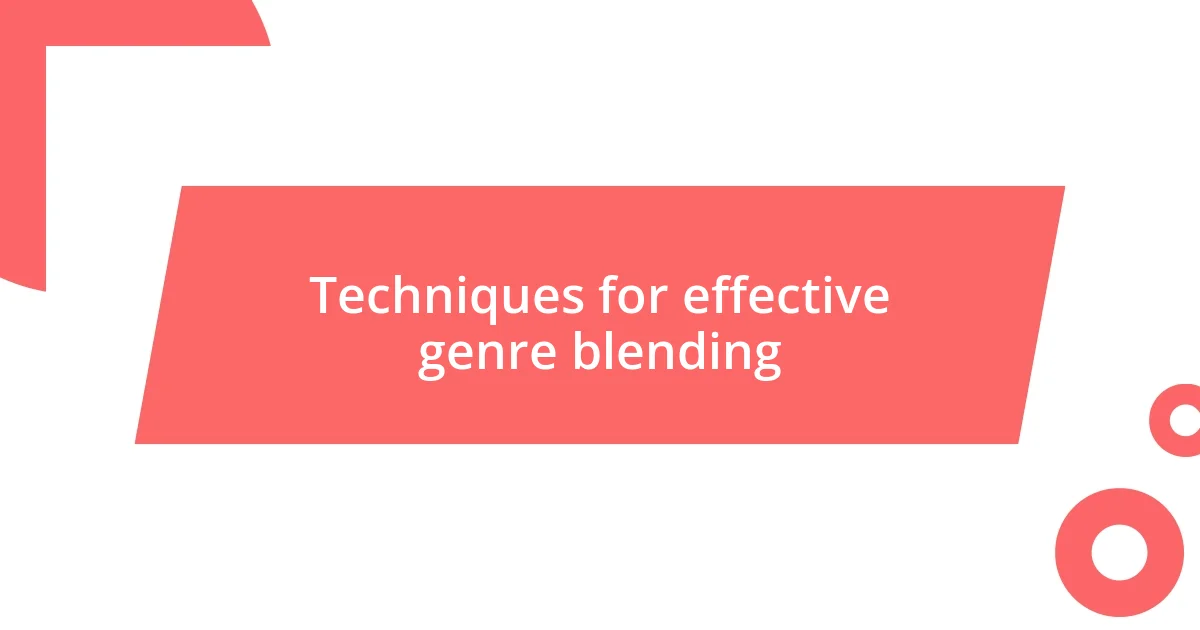
Techniques for effective genre blending
When it comes to effective genre blending, one technique I find particularly valuable is establishing a strong thematic connection. For example, if I’m melding science fiction with romance, I focus on a core theme like ‘love in the face of impossible odds.’ This creates a unified emotional thread that ties the diverse elements together, making the narrative feel cohesive. It reminds me of how I felt when reading a story that paired futuristic technology with heartfelt relationships—it offered a powerful juxtaposition that resonated deeply.
Another technique is to play with narrative structure. I appreciate authors who creatively shift perspectives or timelines, as this can enhance the blending of genres. For instance, a mystery told from multiple viewpoints can intersperse suspense with character introspection, offering a richer reading experience. A particular novel comes to mind where the structure led me through twists that felt both thrilling and reflective, perfectly showcasing how genre elements can harmonize through thoughtful storytelling choices.
Finally, embracing stylistic contrasts can greatly contribute to successful genre blending. I recall enjoying a story where lyrical prose intertwined with punchy dialogue, merging literary and contemporary styles. This clash not only kept the pace lively but also highlighted the distinct characteristics of each genre. Isn’t it fascinating how diverse writing styles within one narrative can evoke varying emotions? It’s like a well-orchestrated symphony, each instrument playing a crucial role in creating an unforgettable experience.
| Technique | Description |
|---|---|
| Thematic Connection | Focus on a core theme that binds the genres together, creating emotional resonance. |
| Narrative Structure | Experiment with different perspectives or timelines to enrich the blending of genres. |
| Stylistic Contrasts | Utilize diverse writing styles within the narrative to evoke various emotions and highlight genre characteristics. |
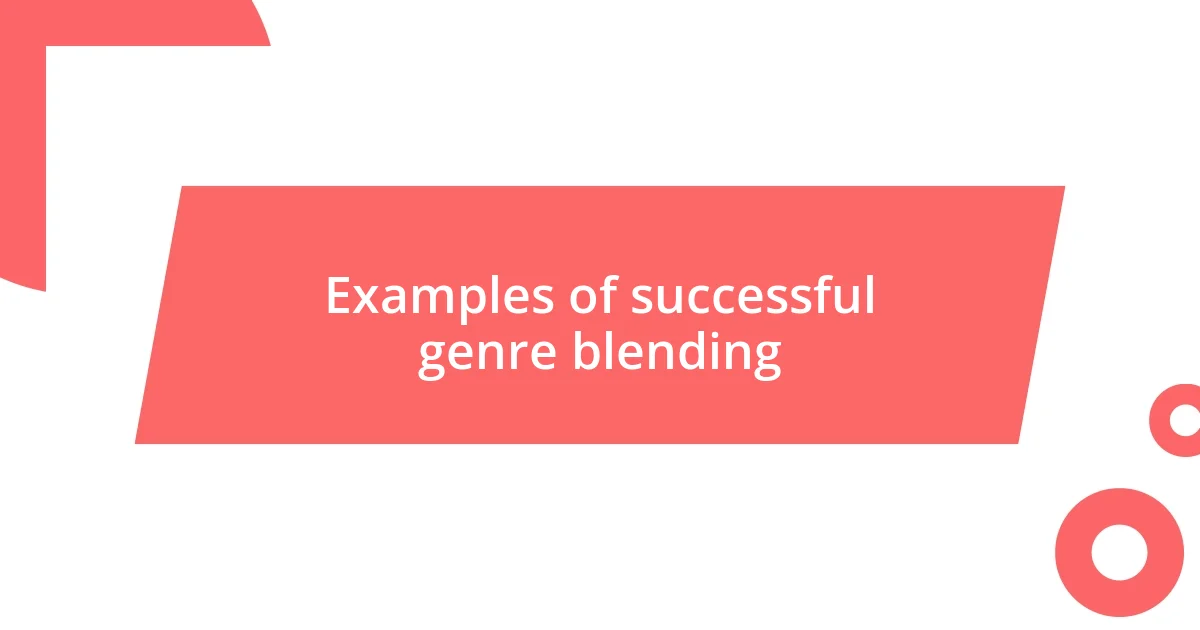
Examples of successful genre blending
When I think of successful genre blending, one standout example for me is Neil Gaiman’s “American Gods.” This novel effortlessly weaves fantasy with elements of mythology and Americana. I remember being captivated by how Gaiman used mythological figures to comment on contemporary society, making me reflect on my own experiences and beliefs. Isn’t it amazing how a story can take familiar characters and place them in unexpected settings, prompting us to reevaluate our understanding of both?
Another remarkable example is the “Harry Potter” series by J.K. Rowling, which blends fantasy with coming-of-age themes. As I followed Harry’s journey, I found myself resonating deeply with his struggles of friendship, identity, and belonging. The magical world felt like a reflection of my own challenges growing up, and that connection made the experience visceral. How many times have we felt inspired by a character not just because of their powers, but because their journey mirrors our own?
Lastly, the graphic novel “Persepolis” by Marjane Satrapi is a profound blend of autobiography, history, and graphic storytelling. When I first dove into its pages, I felt the weight of Satrapi’s experiences during the Iranian Revolution. The combination of stark illustrations with deeply personal narratives created an emotional impact that stayed with me long after I finished reading. Isn’t it extraordinary how these diverse genres can come together to create something uniquely powerful? It drives home the idea that storytelling, in all its forms, can resonate on multiple levels.
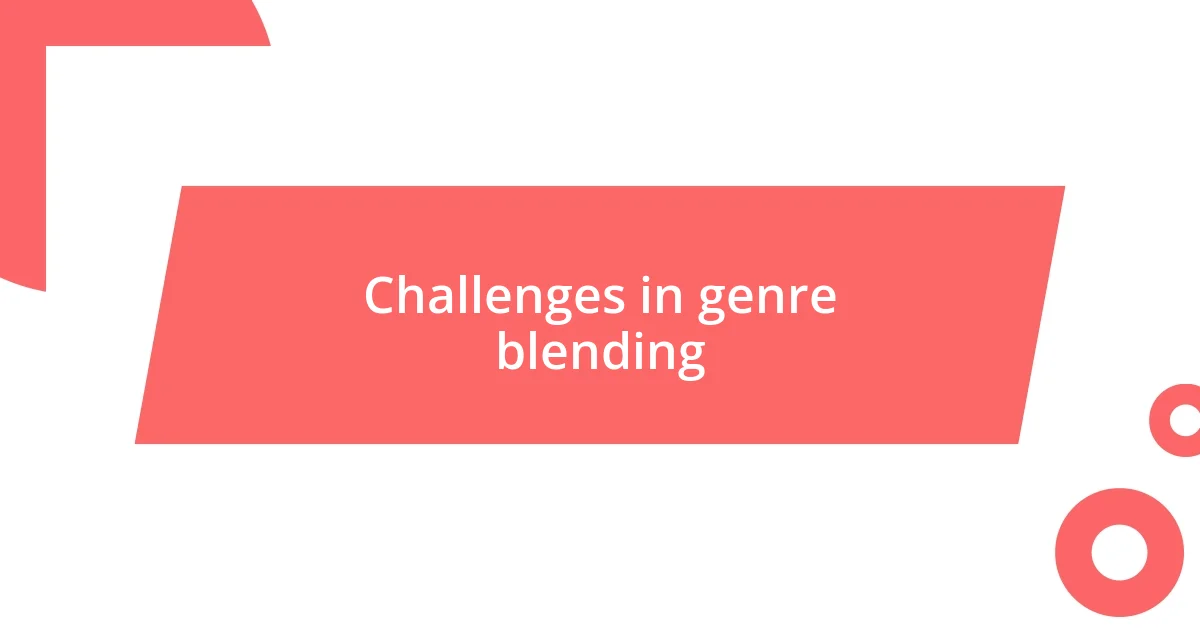
Challenges in genre blending
Blending genres isn’t just about putting two types of stories together; it comes with its own set of hurdles. I’ve often found myself wrestling with the balance between maintaining the integrity of each genre while also creating a unified narrative. For example, when I tried to weave horror elements into a romantic plot, I discovered that the suspense sometimes overshadowed the emotional depth. This struggle left me questioning: how do we ensure that each genre shines without dimming the others?
Another challenge lies in audience expectations. Readers often come with preconceived notions about what a particular genre should deliver. I remember sharing a genre-blended story with friends who typically enjoy straightforward thrillers. Their confusion was palpable when they encountered whimsical fantasy elements intertwined with suspenseful twists. This made me realize how important it is to signal shifts in tone and style, as I want my readers to feel comfortable and engaged rather than bewildered. It begs the question: how do we navigate these expectations while still being creative?
Moreover, there’s the risk of alienating loyal fans of either genre. I think back to a particular novel I read that tried to blend dystopian fiction with a cozy mystery. While ambitious, it ended up leaving both thriller aficionados and cozy mystery lovers feeling unfulfilled. It’s a delicate dance, making sure that the narrative respects the conventions that fans cherish while bringing something fresh to the table. Have you ever picked up a book that felt like it was trying too hard to cater to multiple audiences? That experience often leaves a desire for clarity, don’t you think?
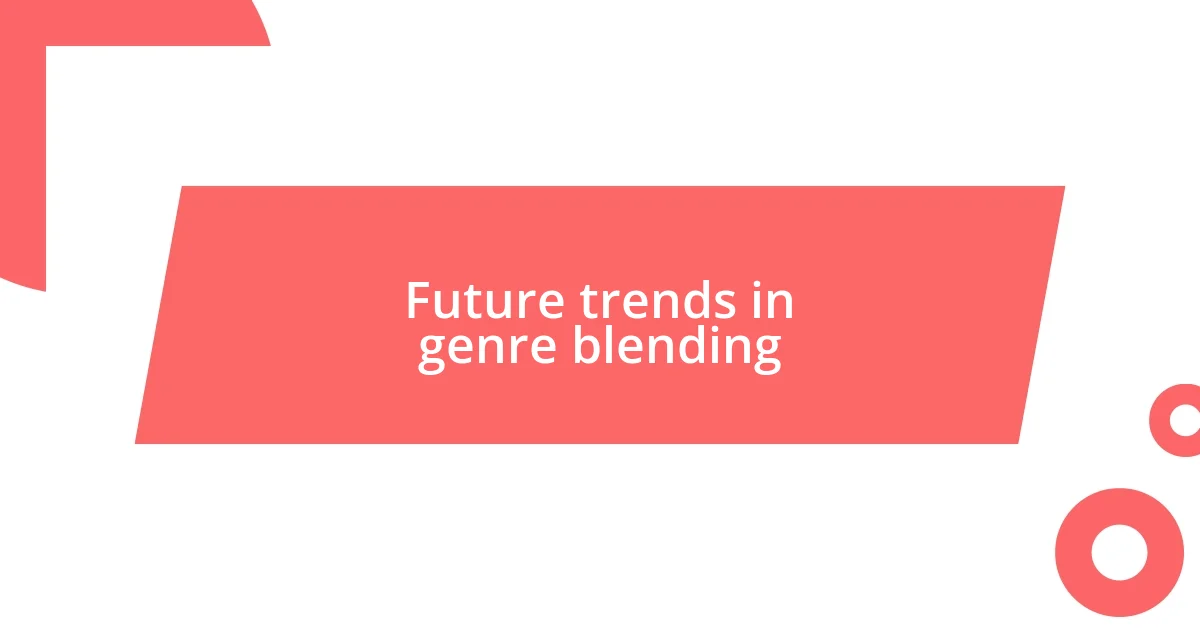
Future trends in genre blending
As I envision the future of genre blending, I’m excited by the potential for even more innovative combinations. Imagine a world where science fiction seamlessly intertwines with memoir, allowing personal experiences to unfold in extraordinary settings. I once attempted to write a short story that merged my childhood memories with futuristic technology. The challenge was exhilarating and eye-opening. Isn’t it intriguing how personal narratives can take on a whole new dimension when framed within an imagined reality?
I also see technology playing a pivotal role in shaping future trends. With the rise of interactive storytelling and augmented reality, readers can engage with genre-blended narratives in unprecedented ways. I remember encountering a choose-your-own-adventure novel that fused adventure and romance; it invited me into the character’s mind in such a visceral manner. Don’t you think this interactive element could transform how we experience stories, making them feel even more personal and tailored to our preferences?
Exploring the themes of identity and culture could become more central in genre-blending as well. We’re already witnessing diverse voices breaking traditional molds, merging genres like magical realism with socio-political commentary. I have this vivid memory of reading a novel that combined elements of fantasy with real-world struggles for marginalized communities. The blend made the social issues hit home in such a powerful way. How else might future storytellers harness genre blending to comment on the complexities of our modern lives? It’s an exciting thought that makes me eager to see what’s next.










